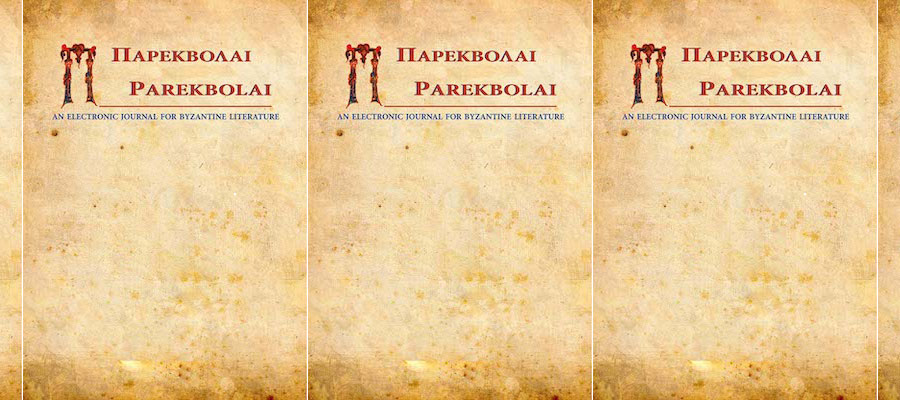Parekbolai. An Electronic Journal for Byzantine Literature, volume 13, (2023).
CONTENTS
The Anonymus Harvardianus, Alessandro Bondino (alias Ἀλέξανδρος Ἀγαθήμερος), and the Role of the Manuscript Napoli III D 37 in Some Editiones Principes of Aristotelian Works
José Maksimczuk
This paper probes the history of the Organon manuscript Napoli III D 37 (ca. 1360-1375). The author offers palaeographical, historical, and text-critical evidence that the Neapolitanus passed through the hands of the so-called Anonymus Harvardianus and Alessandro Bondino by the late 15th and early 16th century. In the second part of the article, the author provides arguments that Napoli III D 37 was one of the manuscripts used by Aldus Manutius and his coadjutors to produce the text of the editio princeps of Aristotle's Analytica priora in 1495.
Diodoro, la Suda e la fine dell'impero di Alessandro Magno. Alcune considerazioni
Elena Santagati
The joint examination of Diodorus 19, 105, 4 and the Basileia lemma of the Suda makes it possible to state that the two texts, although very different and very distant in time, both offer a synthesis of what were the two sources of legitimation of traditional Macedonian kingship - family law and the law of war - applied in sequence, during the first twenty years or so of the struggles of the Diadochi, in the pragmatic and ideological reworking of the new basileiai established after the death of Alexander the Great.
Οι Ομιλίες του Νείλου Ρόδου στον Paris. gr. 1276. Η περίπτωση της Ομιλίας στην παραβολή του Δείπνου
Dimitra Moniou
In this study a new edition of the homily On the parable of the supper by Bishop Neilos of Rhodes (1350-1437) on the basis of MS Parisinus gr. 1276 ff. 189-196v is presented. This manuscript preserves three other Neilos’ speeches, which are to be found in Neilos’ autograph MS Mosquensis Synodalis 434 (492) as well. From the comparison of the two manuscripts it is evident that Neilos, the author being the copyist of the speeches of Parisinus, wrote down a first version of those speeches, which he reworked later on and copied them with his own hand in MS Mosquensis. The differences between the two versions of the text of the homily On the parable of the supper are not negligible: those two versions are published in two columns, so that the reader may see their differences clearly.
Contested Evidence: Patristic Proof Texts in Doctrinal Controversies in Twelfth-Century Constantinople
Dirk Krausmüller
This article focuses on one aspect of the theological discourse in twelfth-century Constantinople: the use of Patristic proof texts. It discusses how three authors whose theological views were deemed heretical by the synod – Eustratios of Nicaea, Soterichos Panteugenos and Constantine of Corfu – sought to back up their positions through recourse to passages from the writings of Cyril of Alexandria, Andrew of Crete and John of Damascus. And it argues that the synod did not always find it easy to propose alternative interpretations of these passages.
Υπατία μεταξύ μύθου και ιστορίας
Silvia Ronchey
Among the many mythological versions of the figure of Hypatia that have developed throughout history and have changed or distorted it, this paper focuses on the two most recent and most prevalent, now that the myth of Hypatia is no longer elite but widespread: the one presented by history of science studies and the one offered by feminist literature.
Regarding the version of Hypatia offered by historians of mathematics, physics and astronomy, this article compares modern hypotheses with ancient sources, demonstrating that the myth of Hypatia as 'Galileo in skirts' is a fallacy: a retrospective projection of the repressive methods of the Catholic Counter-Reformation onto the fifth-century political and ecclesiastical scenario.
With reference to the version of Hypatia presented by feminist literature, the article compares and contrasts the Byzantine image of Hypatia and her sisters in philosophy with that of the feminist or postfeminist movement, starting with information obtained from her contemporaries and generally from ancient literature on philosophae mulieres: a succession only of women, depositary of the oral tradition of those divine “secrets” that Synesius, Hypatia’s best known pupil, mentions in Dion when referring to her.
As a result, we conclude that Hypatia was unquestionably a mathematician, astronomer, and philosopher on the one hand, though not an innovative one; and a priest on the other, in an obscure but no less credible role. An inspired observer of the cosmos and “introducer of the mysteries and orgies of the φιλοσοφία”, a figure not uncommon in fields of knowledge where the perfection of numbers has often been associated with Platonic and neo-Pythagorian mysticism.
